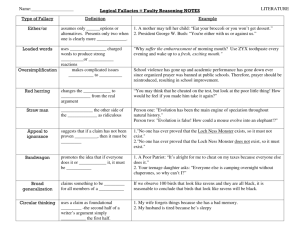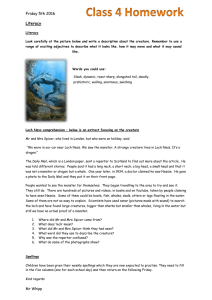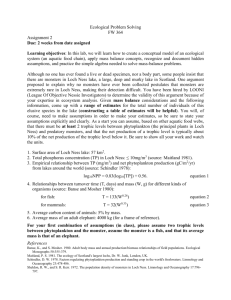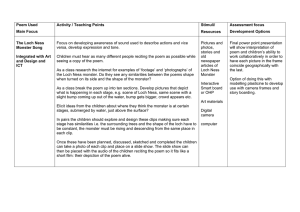Instructions for Preparing a Report of Findings
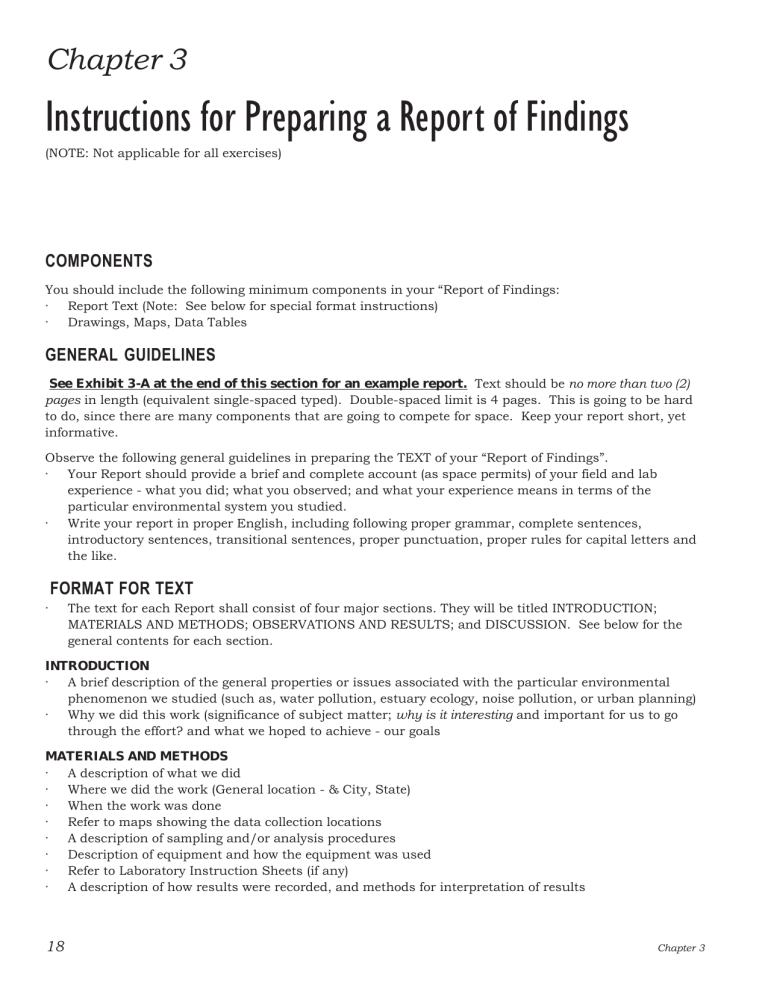
Chapter 3
Instructions for Preparing a Report of Findings
(NOTE: Not applicable for all exercises)
COMPONENTS
You should include the following minimum components in your “Report of Findings:
· Report Text (Note: See below for special format instructions)
· Drawings, Maps, Data Tables
GENERAL GUIDELINES
See Exhibit 3-A at the end of this section for an example report.
Text should be no more than two (2) pages in length (equivalent single-spaced typed). Double-spaced limit is 4 pages. This is going to be hard to do, since there are many components that are going to compete for space. Keep your report short, yet informative.
Observe the following general guidelines in preparing the TEXT of your “Report of Findings”.
· Your Report should provide a brief and complete account (as space permits) of your field and lab experience - what you did; what you observed; and what your experience means in terms of the particular environmental system you studied.
· Write your report in proper English, including following proper grammar, complete sentences, introductory sentences, transitional sentences, proper punctuation, proper rules for capital letters and the like.
FORMAT FOR TEXT
· The text for each Report shall consist of four major sections. They will be titled INTRODUCTION;
MATERIALS AND METHODS; OBSERVATIONS AND RESULTS; and DISCUSSION. See below for the general contents for each section.
INTRODUCTION
· A brief description of the general properties or issues associated with the particular environmental phenomenon we studied (such as, water pollution, estuary ecology, noise pollution, or urban planning)
· Why we did this work (significance of subject matter; why is it interesting and important for us to go through the effort? and what we hoped to achieve - our goals
MATERIALS AND METHODS
· A description of what we did
· Where we did the work (General location - & City, State)
· When the work was done
· Refer to maps showing the data collection locations
· A description of sampling and/or analysis procedures
· Description of equipment and how the equipment was used
· Refer to Laboratory Instruction Sheets (if any)
· A description of how results were recorded, and methods for interpretation of results
18
Chapter 3
OBSERVATIONS AND RESULTS (Just the Facts, Ma’am)
· A concise description of pertinent observations - NO INTERPRETATIONS!
· What we discovered
· “Field Observations” should consist of a summary of specific observations made at each sample point, or stop in the field. “Results” should consist of a series of statements which point out important data, and identify trends in collected data.
· Data tables, graphs
DISCUSSION
· OK. So you went out there and looked around, and found some stuff, and recorded a bunch of data, and described the data - SO WHAT! Now, what does it all mean?
· Discuss the significance of your results and observations. What insights do your observations provide into the function of the subject system.
· What is particularly interesting or surprising?
· Recommendations?
ILLUSTRATIONS, TABLES AND OTHER ATTACHED MATERIALS
Most reports will require the inclusion of some form of attached materials. These will come in the following general forms:
FIGURES
· illustrations, photos, drawings
TABLES
· lists, tables, data entry forms
EXHIBITS
· other kinds of materials that don’t fit into the above categories
Figure 1 at the back of this section is an example figure. It includes instructions on how to set up a title block, where to put a “north” arrow, and how to label your drawing. Drawings can express much, and can save you lots of writing. Just remember to label your drawings in order to highlight that which you want your readers to see.
REFERRING TO TABLES, FIGURES AND EXHIBITS
If you include tables, figures or exhibits in your report, you must make some kind of reference to them in the body of your report. Otherwise, the reader may not see them, and will not know in what context to view them if he/she stumbles upon them. Referring to these attachments is simple. Here are two examples below:
“See Figure 1 for location of sampling points.” or
“The team collected six samples from the study area (Figure 1).”
Use this same format for tables and exhibits. This convention also is used throughout this lab manual.
BINDING YOUR REPORTS
FOR MARK PARRAT’S STUDENTS
Please bind all your submittals in a suitable folder or binder, in accordance with Mr. Parratt’s instructions.
FOR TOM MORRIS’S STUDENTS
Please do not use folders or binders of any kind. Instead, please bind your reports by placing a staple in the upper left-hand corner.
Instructions for Preparing a Report of Findings
19
Exhibit 3-A
Example Report of Findings
Title, Name and Lab Section
Include headings for major sections
Set the stage. Give background that establishes why the problem is interesting.
State the purpose of the report.
Include date and specific locations.
Refer to graphics as
"Figures".
Describe the general way you used special equipment.
Summarize your objective findings.
Do not repeat every detail in your data collection sheet.
Describe only the highlights.
Do not attempt to interpret your results here.
Interplanetary Natural History of the Loch Ness Monster
J. R. "Bob" Dobbs
Environmental Biology Laboratory
Monday 3:00 A.M.
INTRODUCTION
For several centuries there have been numerous reports of a mysterious, creature at Loch Ness in Scotland. Known as the “Loch Ness Monster”, this organism has successfully eluded efforts to obtain verifiable observation, in spite of its reputed huge size. Ecologists have argued that such a monster could not long survive in the loch (lake), because the net primary productivity of small Loch Ness is insufficient to feed such a large beast. Still, some explanation is needed to reconcile the continuing sightings with the productive limitations of the loch in which it lives. Ironically, the answer may not be found on Earth, but in space.
Since the exploration of space, scientists have made many unusual and otherwise unexplainable observations on Venus and Mars such as fossil-like rocks, and strange movements in the Martian atmosphere. These observations could be linked to the Loch Ness Monster. When studied together, it is reasonable to ask the following question. Is it possible that the Loch Ness monster travels between Venus, Earth and Mars? Therefore, the purpose of this report is to explore the possibility that Earth may be an intermediate rest stop on the monster’s interplanetary wanderings.
MATERIALS AND METHODS
On September 5, 2093, members of the Environmental Biology Lab donned space suits and visited Venus and Mars. We used “farcaster portals” at the Jet
Propulsion Laboratory in Pasadena, CA. The farcasters work on a principle of folding space-time, enabling instantaneous access to planetary destinations, without incurring relativistic time debt. This means we could visit Venus for a few hours and be back in time for our next class. While on Venus, we visited the deep rift valley at Beta Regio during this region’s winter (Figure 1). On
Mars, we explored the caldera of large Olympus Mons during this region’s summer
(Figure 2).
We used a monster field identification guide to identify observed monsters.
Tricorders helped us locate monster nests, and track monster movements, including interplanetary trajectories. Picks, shovels and other hand tools were used to excavate artifacts. Monster dung was investigated for signs of
Loch Ness vegetation and fish. Observations were recorded in Table 1.
OBSERVATIONS AND RESULTS
The Venus investigation yielded abundant results (Table 1). We discovered a complete 30-feet long skeleton of an organism matching the description of the
Loch Ness Monster. At least twelve 1-foot diameter eggs were present.
However, tricorder readings indicated that the eggs were no longer alive. No live monsters, dung or any other artifact that would indicate ongoing existence on Venus were observed. Fossils of numerous other animals and plants also were discovered at the site. However, the most surprising find of all was the presence of ruins from ancient modern settlements. These ruins contained artifacts of advanced electronic equipment and machinery.
1
Refer to lists as "Tables"
Note these two ways of refering to attachments.
Number all pages
20
Chapter 3
Mars presented an interestingly different picture. We made six different sightings of Loch Ness monsters (Table 1). One sighting was of two monsters entering the Martian atmosphere while traveling at a velocity of 18,000 miles per hour. Tricorders indicated a hyperspace disturbance immediately prior to atmospheric contact. From the high vantage point atop Olympus Mons, we observed monsters disappearing below the Martian surface, and re-emerging. Tricorders indicated that large broken egg shells near a deep crevasse still possessed live residue, indicating these eggs had recently hatched. Dissection of several dung piles revealed partially digested fragments of cattails, rushes, and fish known to be native to Loch Ness.
Always base your interpretations on your observations.
Make this point very clear.
DISCUSSION
Based upon these observations, the natural history of the Loch Ness Monster may be far more complex and mysterious than previously imagined. Instead of being an
Earth-bound relict from the dinosaur past, it actually may be a refugee in search of new habitat in the solar system. The absence of life forms on Venus, along with the decomposed remains of Loch Ness Monsters and eggs could indicate that the monster once inhabited Venus, but no longer lives there. Since the atmospheric pressure and temperature are extremely high on Venus, it is unlikely that life could now exist there. However, the presence of fossils presents new evidence that Venus at one time could have supported a thriving ecosphere. If so, something went terribly wrong.
Attempt to assemble new understandings.
What new and interesting things could your observations mean?
The numerous sightings of live monsters on Mars could indicate that the monsters have established residency on Mars. Tricorder velocity readings of 18,000 m.p.h.
during atmospheric re-entry indicate that the monster possesses the capability of space travel. The distortion in hyperspace detected prior to re-entry could indicate the capacity for hyperlight propulsion, a totally unexpected observation.
Since we visited Olympus Mons during that region’s summer season, subterranean water could exist in a liquid state. The observations of monsters going below the ground surface could mean they have discovered sources of liquid Martian water.
If so, the existence of truly Martian life re-emerges as an exciting possibility.
Unless you are dead certain, use conservative language like,
"could be", or " may have", or
"could mean".
Limit the text portion of your report to two pages. like this.
I will attempt to consolidate these observations into a cohesive explanation of the Loch Ness Monster’s recent natural history. It is possible that the Loch Ness
Monster once was part of the Venusian ecosphere. The existence of life there must have lasted for billions of years — enough time for the development of a species sophisticated enough for hyperlight travel. Such a capacity could only be supported by a dense industrial economy whose need for hyperlight travel increased as did the level of industrial activity. Ironically, the very industrial base needed to develop such a propulsion system also could have so damaged the planet as to destroy its ecological structure. The Loch Ness Monster may have used this technology to escape the deteriorating Venus. Its first stop may have been Earth.
The Loch Ness Monster may have colonized Earth millions of years ago. It could have occupied many lakes around the globe up until the emergence of modern human beings about 100,000 years ago. For whatever reason, the monsters may have sought an alternative habitat — Mars. The monsters may have begun to colonize Mars, seeking limited subterranean water resources there, migrating north and south to follow the Martian summer. So, why the monsters in Loch Ness, and can the loch support these monsters? These questions remain unanswerable. However, the evidence suggests that Loch Ness may not be required by the monster as a permanent home. If so, this would explain why sightings are intermittent. Regardless, these observations shed astonishing new light on an ancient mystery, and raise surprising new questions about the Loch Ness Monster.
2
Include certain details to make this section more informative.
Prepare your
DISCUSSION section so that it remains consistent with your stated purpose (see your
INTRODUCTION).
Make interpretations of interesting, individual observations.
Then try to assemble these individual observations into an emerging whole picture of the problem.
What does it all mean relative to the problem you originally posed in your
INTRODUCTION section?
Instructions for Preparing a Report of Findings
21
22
All tables need a number and a title.
Place tables figures and exhibits after your written text portion of the report.
Table 1
Summary of Planetary Observations
VENUS MARS
Air Temp.
Live Loch Ness Monster
Sightings
850° F
None observed
-40° F
Fossil Loch Ness Monsters One complete 30' long skeleton. Numerous other fragments
Other Fossils
None
One sedimentary rock outcrop with many fossils.
Diverse assemblage of plant and animal-like organisms. 12 egg shells, one foot in diameter.
None
Evidence of Civilization
Six live monsters sighted. Two were entering atmosphere from space travelling at
18,000 mph. Tricorder readings detected distortion in hyperspace field before entry into atmosphere.
Shallow excavations revealed ruins of what looks like an ancient industrial city.
Artifacts include: printed circuit boards, machined parts.
None
3
Chapter 3
All figures need a number and a title.
Figure 1. Venus study site at Beta Regio.
Instructions for Preparing a Report of Findings
Figure 2. Mars study site at Olympus Mons.
4
23
